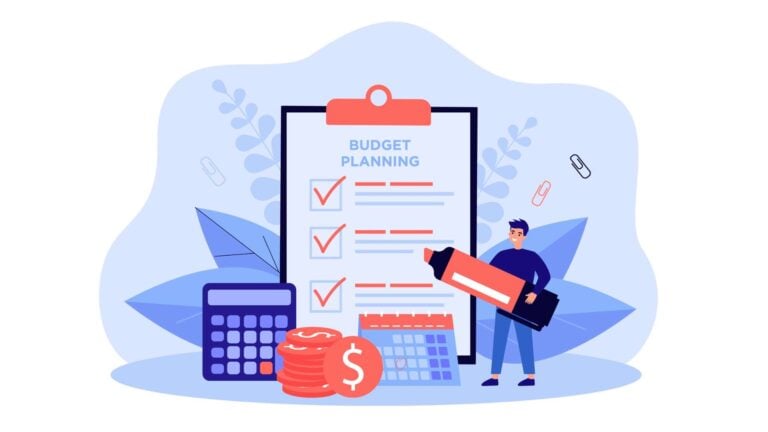A budget for business helps you understand, manage, and improve your company’s finances. This article explains how to create a business budget, the benefits of doing so, and common pitfalls to avoid.
How To Create a Business Budget for Your Small Business
Your reasons for creating a business probably didn’t include an overwhelming desire to plan a budget. Budget planning can be confusing and time-consuming, but it’s essential to being a business owner.
A detailed budget serves as a roadmap for your company’s success, helping you understand your revenue and expenses over a given period of time so you can make long-term goals to achieve sustainable growth as a small business. Knowing how to create a business budget will also help you avoid losing too much money, falling behind on taxes or debt repayment, or spending more than you should on business costs.
In this article, we walk you through how to make a business budget for your small business, tips for business budgeting, and common challenges and pitfalls to avoid. Let’s dive in!
Key Takeaways
- A business budget helps you manage your company’s revenue and expenses. Business budgeting is an important part of running and managing a business.
- Creating a small business budget offers many benefits, including financial control, more oversight over goals, better cash flow and expense management, and preparation for tax time.
- When creating a budget for business revenue and expenses, start by gathering data, making a plan, setting a timeframe, and designing the budget structure. Then, assess cash flow, set aside funds for unforeseen expenses, and calculate your profit and loss.
- Be vigilant of common pitfalls, like being too optimistic, ignoring expenses or taxes, forgetting to save, or not prioritizing budget updates.
What Is a Business Budget?
Simply put, a budget is the plan for managing your company’s expenditures. Planning ahead of time enables you to enter into business agreements, purchases, and sales with an understanding of how these may affect your bottom line.
When you run a small business, every dollar counts, so it’s important to learn how to make a business budget. Once your budget is up and running, you can use it to project how much income you expect, decide what to spend that revenue on, and compare the differences between what you budgeted and what actually occurs.
Benefits of Creating a Business Budget
When you create a business budget, you can:
Have better financial control and set strong goals
Using your budget as a roadmap, you can stay in charge of your company’s income,
expenses, and overall resource allocation. This puts the control in your hands, enabling you to use every dollar wisely by setting clear and achievable financial goals. You can make strategic adjustments to your budget in real-time, ensuring your business meets its main objectives and continues to grow.
Stay on top of your cash flow
With a business budget, you can keep track of your cash flow—the movement of money in and out of your business. This prepares you for the ebbs and flows of running a business. You can be ready for slower periods of less incoming cash and form a plan for times of surplus.
Lower your company’s expenses
While almost every business will have some operating expenses, there are often ways to optimize these to save money. Creating a business budget allows you to go through your expenses with a fine-toothed comb and see what can be removed or limited.
Better plan for tax season
Tax time can be stressful for small business owners, but a budget can help you feel more prepared for tax season. You can come up with an estimate of your taxable income and make a plan for paying your taxes.
How To Create a Business Budget
While there are many different types of budgeting, an operating budget is ideal for many small businesses. Because these budgets help you forecast expected revenues and expenses over a specific period, they enable you to make informed decisions about day-to-day operations.
Below are the steps for creating a basic operating budget.
Step 1: Gather data
First, take stock of any financial data your company has, including both revenue (the total money coming in) and outgoing expenses (including the direct costs of producing your product or service and the broader operational costs that aren’t directly tied to production).
This data could be in the form of income statements, current or former balance sheets, or cash flow statements. You’ll use this information later in your calculations.
Step 2: Make a plan
Then, think through your financial goals for the business. Based on the data you have, what are your goals? For instance, do you want to increase revenue, decrease expenses, or a mix of both?
Knowing this will help you create a budget that meets your needs and enables you to achieve those goals. For example, should you want to increase revenue, you might allocate more funds to marketing and sales strategies.
Step 3: Decide on a timeframe
Next, decide on the budgeting timeframe. An operating budget is often created on a monthly, quarterly, or yearly basis, with annual being the most common.
Consider your business objectives when choosing your timeframe. For short-term goals, you might want a shorter timeframe for your budget, like monthly or quarterly. Businesses in seasonal industries might use short-term budgets to assess seasonal fluctuations.
You should also consider how far into the future you can reasonably forecast things like revenue. Use that information to decide on a budgeting timeframe.
Step 4: Structure your budget
When you’re ready to set up your budget, think about what information to include, as well as the best way to track the information.
For example, many businesses create budgets in spreadsheets, but you could use software designed for budgeting or business management. Or, you could simply use a pen and paper. Each method will help you create a “budget sheet” with rows and columns to visualize your budget.
No matter your method, you’ll want to add rows for each of the following categories. (We’ll cover what each of these means shortly.)
- Anticipated revenue.
- Fixed costs.
- Variable costs.
- Any estimates of one-time or unexpected costs.
- Emergency funds.
You must also add rows for calculations, which we’ll walk you through in a bit.
Also, add columns for the “actual” amount (the actual number) and the “budgeted” amount (the number you anticipate and project).
Step 5: Assess your revenue
Now, it’s time to get into the details. Using the financial data you gathered in Step 1, include all your business’s revenue sources in your budget sheet. Start with income from sales or services, then consider any investments your business holds, grants you’ve received, or other income streams.
Once you have a sum, estimate your expected revenue for the budgeting period. You can base these projections on past data, market research, and sales forecasts. Include this in a row labeled “Revenue.”
For example, a clothing store owner may have sold $24,000 in accessories and $60,000 in clothing last year. If they project a $10,000 increase in revenue this year, they would set a revenue budget of $94,000.
It’s up to you if you want to include your past revenue on your budget sheet. You can create a column labeled “Historical Revenue” or something similar if you choose to. Then, you might compare this against your current projected and actual revenue.
Step 6: Assess your costs
All small businesses have some outgoing expenses, and you must include them in your budget.
Using the financial data you gathered in Step 1, think about your business’s operating expenses. Be sure to consider both fixed and variable expenses.
Fixed expenses don’t change, or at least don’t change very often, while variable costs can fluctuate over time. Fixed costs could be your rent or insurance, while expenses like supplies or marketing could fluctuate based on business activity and needs.
For example, your budget might include a fixed cost of $15,000 in rent and a variable expense for utilities, which fluctuates based on the season. Take an average of past utility bills and use that to set a reasonable budget for the coming year.
Be sure to add rows for each type of expense along with the anticipated budget. Don’t forget to factor in estimated unexpected costs and any irregular expenses that may come up, like legal fees.
Step 7: Plan for challenges
Unexpected expenses are part of running small businesses, but there are other reasons to form a contingency plan in your budget. You should save money in case you face challenges, like the economy shifting and sales decreasing. Be sure to allocate some of your budget to a contingency or emergency fund so you have a safety net.
For example, if you spent $10,000 on unexpected expenses last year, you could project something similar for the future and create a budget line item accordingly. For an annual budget, you might add a row for “Emergency Expenses” and allocate $10,000.
Alternatively, you could allot 5% or 10% of your overall budget to your emergency fund.
Example budget sheet for steps 4-7
Once you’ve done these steps, your budget sheet might begin to look something like this (although it will likely have more line items):
| Revenue | Budget | Actual |
| Revenue – Sales | $25,000 | $30,000 |
| Revenue – Grants | $10,000 | $10,000 |
| Revenue – Total | $35,000 | $40,000 |
| Expenses | ||
| Expenses – Rent | $20,000 | $20,000 |
| Expenses – Wages | $10,000 | $7500 |
| Expenses – Emergency | $2,000 | $900 |
| Expenses – Total | $32,000 | $28,400 |
Next, let’s walk through how to calculate your profit and loss.
Step 8: Calculate your P&L
A profit and loss (P&L) statement is a financial statement summarizing your revenue and expenses during a given period. It shows you if your business is making a profit, incurring a loss, or breaking even.
Even though this statement is typically separate from your budget, calculating your P&L is a crucial part of budgeting since it uses your budgeting information and informs your budget projections.
You can use your budget sheet to determine the numbers for your P&L calculations. Here’s what you should consider:
- Revenue is the total income you’ve generated from sales of goods or services (or other streams of income).
- Cost of goods sold (COGS) refers to the costs of raw materials, labor, or other costs associated with the goods or services you provide.
- Gross profit, calculated by subtracting COGS from revenue, is the profit your small business makes after factoring in the costs of production.
- Operating expenses are costs associated with running the business day to day. These include employee wages, rent, marketing, utilities, or other administrative expenses.
- Operating income, which you can calculate by subtracting total operating expenses from your gross profit, reflects the profit or loss from your business operations.
- Other expenses/income is the part of the budget that accounts for any additional money (going out or coming in) that isn’t factored into the core operations. Examples include income from interest, losses or gains from investments, or one-time expenses or windfalls.
- Net profit, also known as net income, is your budget’s bottom line. This represents the total profit or loss after considering all possible aspects of your company’s finances. You can calculate this by subtracting other income and expenses from your operating income.
After you’ve done these calculations, you’ll better understand whether your business is expected to make a profit or loss during your budget period. This gained knowledge is what makes creating a budget important.
Example P&L calculation
Imagine your revenue is $100,000. The COGS is $10,000. To calculate gross profit, you’ll use this formula: Revenue – COGS = gross profit.
$100,000 – $10,000 = $90,000
Let’s say your operating expenses are $30,000. Figure out your operating income with this formula: Gross profit – operating expenses = Operating income.
$90,000 – $30,000 = $60,000
Then, look at any other income or expenses. Let’s pretend this is $10,000. You’ll subtract that from the operating income with this formula: Operating income – other income = Net profit.
$60,000 – $10,000 = $50,000
Your net profit, then, is $50,000.
📚This Might Interest You:
Read Connecteam’s guide on how to calculate, track, and reduce overhead costs.
Step 9: Keep it balanced
Business budgeting only works if you keep your budget balanced and up to date.
Set reminders to update your budget with actual revenue and costs regularly. For example, for a monthly budget, you should update the budget each month.
As you make these updates, ensure your projected revenue continues to be equal to or greater than your projected expenses and your profit is greater than your loss. When that isn’t the case, you may need to adjust the budget or find additional opportunities to cut costs or increase cash flow.
Over time, compare your budget to actual financial results as they come in. Use this information to adjust your budget based on your business’s real performance.
Common Pitfalls When Creating a Business Budget
Avoid these common mistakes business owners make when learning how to make a business budget.
Projecting too optimistically
Of course, you want your business to succeed, but be sure you’re realistic about the revenue you project. Overestimating your sales and revenue could result in an unbalanced budget that causes issues down the line.
This can happen with expenses, too. Try not to underestimate your expenses, as this will also lead to an unbalanced budget.
Not paying attention to variable, tax, or debt expenses
While it’s usually true that fixed expenses are the highest costs in your budget, it’s important not to lose sight of the variable costs.
By their nature, variable expenses fluctuate and can greatly impact your company—especially when high fluctuations occur. Overlooking these costs can result in unexpected financial shortfalls, putting strain on your cash flow.
For the same reasons, don’t forget to factor tax payments and debt obligations into your budget.
🧠 Did You Know?
Connecteam makes it simple to keep track of business expenses, including easy-to-forget variable costs and tax estimates, with its intuitive forms and checklists feature.
Forgetting to save
Contingency planning is vital to the success of your business. When you forget or choose not to allocate funds for emergencies or contingencies, you risk being hit hard by revenue shortfalls or unexpected costs.
Setting and forgetting your budget
A budget should be a living document that changes as your revenue and costs change. Keep track of what actually occurs so you can adjust your budget as needed.
FAQs
What should a business budget include?
A business budget should include your projected and actual revenue, projected and actual expenses (including variable expenses and one-time costs), and calculations to determine your profits.
How do I create a budget spreadsheet for my business?
Gather the data to include, then create your spreadsheet with rows or columns for revenue or sales, fixed costs, variable expenses, and other projected costs. You can set formulas to do the calculations for you.
How do I create a budget spreadsheet for free?
To create a budget spreadsheet, you can use free tools like Google Sheets. Add line items for each part of your budget—revenue from sales, other income, fixed and variable expenses, and anything else you want to capture—then include calculations to understand your profit and loss.
🧠 Did You Know?
For a free way to create a budget that’s even better than a spreadsheet, consider using business management software. A great option is Connecteam, which lets you use forms and checklists to track information over time. It also offers many other features to help you run your business and a free-forever Small Business Plan.
The Bottom Line on Business Budgets
A business budget sets you up for continued success by helping you analyze, manage, and update your company’s financial details as needed. When you have a solid budget, you won’t be left wondering where your money is going or when you can expect cash flow. Instead, your company’s financial information will be at your fingertips.
Creating a small business budget requires understanding your financials and cash flow, determining how to structure the budget, tracking incoming and outgoing money, allocating funds for contingencies, and calculating your profit and loss.
Connecteam can help you track and manage expenses and simplify every aspect of small business management.




